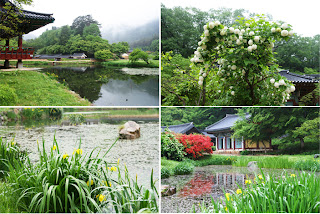The weather is beautiful these days and I wanted to go anywhere to refresh.
I arrived at youngdeok “Sunshine park”.
The park is well organized with wild flowers, hiking paths, observation decks, resting places, and reeds.
It is a wonderful place where you can relax.
Next, I moved to Uljin Bulyoung-sa temple.
There is very famous “Vegetable Bibimbob” restaurant.
I Could not miss it.
Bibimbob is one of my favorite Korean food.
This is a menu. I could read Korean.
HAHA. Bibimbob is 6,000 won.Look at those yummy foods.
The entire dish was so delicious. I ate it all!! So Yum!!
This is the bulyoung-sa main gate.
Even thought it was rainy day, there were pretty lots of people.
Look, so many people~~
There was very nice road to walk until get to the bulyoung-sa.
When I almost get there I found one dead tree. It was 1300 years.
For commemorate this tree, people pile up the stone.
Bulyoungsa entrance.
There was a rock on the top. It looks like a Buddha.
People could see the rock’s shadow on the lake.
That’s why the name of the temple was Bulyoung-sa.
This guy was looking at the Buddha’s shadow.There was also old tree. The tree was 600 years old.
A long time ago, this tree was struck by lightning in a thunderstorm.
This is Bulyoung-sa three story stone pagoda.
Enjoy bulyoungsa’s beautiful view.
The aquarium has many kind of fish.
This aquarium was full of fishes that very rear species.
Wow ~ this is Uljin’s famous star king crab!
It was very big. And looks yum~
This is huge octopus. It’s also huge. I just paused to look at the octopus.
This is true seals. This seals was doing cute performance.
Lot of people was looking at it. It was so cute.
Time flies when I was watching fishes.
It’s a rainy day today which is my favorite day.
I heard that there is “ Gyeongbuk Theme travel” event in gyeongbuk area.
It just started yesterday, so I already miss one day.
Anyway I decide to go there.
It just started yesterday, so I already miss one day.
Anyway I decide to go there.
I arrived at youngdeok “Sunshine park”.
The park is well organized with wild flowers, hiking paths, observation decks, resting places, and reeds.
It is a wonderful place where you can relax.
It is a beautiful park with "music" and "sculptures."
It also has nickname as Chameleon.
Cause all 4 season has different attraction and beautiful view.
It also has nickname as Chameleon.
Cause all 4 season has different attraction and beautiful view.
Next, I moved to Uljin Bulyoung-sa temple.
There is very famous “Vegetable Bibimbob” restaurant.
I Could not miss it.
Bibimbob is one of my favorite Korean food.
This is a menu. I could read Korean.
HAHA. Bibimbob is 6,000 won.Look at those yummy foods.
The entire dish was so delicious. I ate it all!! So Yum!!
This is the bulyoung-sa main gate.
Even thought it was rainy day, there were pretty lots of people.
Look, so many people~~
There was very nice road to walk until get to the bulyoung-sa.
When I almost get there I found one dead tree. It was 1300 years.
For commemorate this tree, people pile up the stone.
Bulyoungsa entrance.
There was a rock on the top. It looks like a Buddha.
People could see the rock’s shadow on the lake.
That’s why the name of the temple was Bulyoung-sa.
This guy was looking at the Buddha’s shadow.
A long time ago, this tree was struck by lightning in a thunderstorm.
After that people tried to save it, so the tree is still alive safely.
This is Bulyoung-sa three story stone pagoda.
Enjoy bulyoungsa’s beautiful view.
Because of the rain I feel very fresh. A green grass scent makes me cool~
The aquarium has many kind of fish.
Come connect with the wonderful of sea creatures at the Uljin aquarium.
This aquarium was full of fishes that very rear species.
Wow ~ this is Uljin’s famous star king crab!
It was very big. And looks yum~
This is huge octopus. It’s also huge. I just paused to look at the octopus.
This is true seals. This seals was doing cute performance.
Lot of people was looking at it. It was so cute.
Time flies when I was watching fishes.
A somnolent Sunday afternoon, I did short trip in Gyeongbuk.
Gyeongbuk is the place you can enjoy your eyes and mouth at the same time.
Because of my favorite rainy day, I enjoy this trip more I guess.



























































































